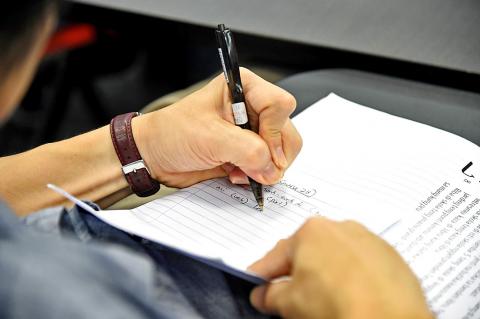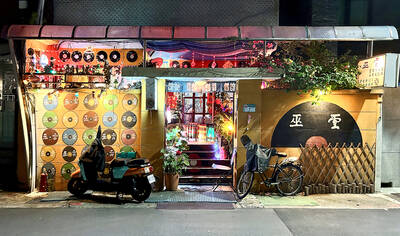Kevin Martens Wong reels off sentences in Kristang, which is among several minority languages in Singapore enjoying a new lease of life after a decades-long drive to encourage the use of English and Mandarin.
“Teng bong, ozi nus prendeh sorti-sorti di tempu,” the linguist told his eager students in the 500-year-old mish-mash of Portuguese and Malay — a greeting, and information that the class would be about the weather.
A former British colonial trading post that has long been a melting pot of different cultures, Singapore has an ethnically diverse population whose ancestors mostly came from across Asia, principally China, India and the Malay archipelago.

Photo: AFP
On independence in 1965, Singaporeans spoke an array of tongues.
English was common, but many used Chinese dialects, such as Hokkien, as well as Tamil from India, Malay and a smattering of more obscure languages.
But authoritarian founding prime minister Lee Kuan Yew (李光耀) believed change was necessary to ensure a secure future for the tiny city-state, which had been thrown out of neighboring Malaysia following a brief and stormy union.

Photo: AFP
He made the study of English compulsory in schools as he positioned the country as a global commerce and finance hub, as well as one other “mother tongue.”
For local ethnic Chinese, who today make up the majority of Singapore’s population, it was usually Mandarin, as Lee had an eye on China’s rise as a world power, while it was Tamil or Malay for other citizens.
CONTROVERSIAL POLICY
The policy initially ran into opposition from ethnic Chinese, most of whom trace their ancestry to southern China. Lee, who ruled Singapore for over three decades and died in 2015, described in his memoirs how he had to force the issue.
“To emphasize the importance of Mandarin, I stopped making speeches in Hokkien,” wrote Lee, who was ethnic Chinese, while most TV and radio broadcasts in Chinese dialects were also stopped.
Those restrictions still stand except in special cases, such as radio news broadcasts in Chinese dialects for senior citizens who struggle with Mandarin.
Non-Chinese tongues, such as Kristang, spoken by descendants of Portuguese colonizers who arrived in what is now Malaysia in the 16th century and married locals, also faded.
One thing that unexpectedly flourished was “Singlish,” a local patois that mixes English with words from the myriad tongues spoken in Singapore. It is still widely used, despite official efforts to discourage it.
In recent years however Singaporeans have taken more of an interest in their ancestors’ languages.
As well as Kristang, efforts have been made by organizations promoting Chinese culture to keep Hokkien alive. It is the Chinese dialect that is most common in Singapore but it has become less widespread, particularly among the young.
Other minority languages enjoying renewed attention include Baba Malay, spoken by descendants of Chinese immigrants who married into the local Malay population, which mixes elements of Malay and a Chinese dialect, and Boyanese, a language from a corner of Indonesia.
RECONNECT WITH THE PAST
Observers see a relaxation in attitudes towards the old languages in the city-state of 5.6 million, which has grown into one of the world’s wealthiest and most stable societies.
Most Singaporeans have already achieved an enviable level of English by international standards, lessening fears that focusing on other tongues will affect their English-speaking ability. There has also been growing concern about losing touch with the past.
Young Singaporeans’ desire to revitalize the languages is a “form of root-tracing” while for the older generation it’s due to a sense of nostalgia, associate professor Tan Ying Ying, head of linguistics at Singapore’s Nanyang Technological University, said.
“Linguists working in Australia, New Zealand, and the US, have dedicated frameworks and systems to revitalize minority languages that are in danger of being extinct,” he said.
“In Singapore, while there is such no formal system in place, the sense that these languages need to be ‘saved’ is felt by the communities of speakers themselves.”
The students learning Kristang — spoken in parts of the Malaysian city of Malacca as well as Singapore — attend classes led by Wong, 25, thrice weekly, and range from young professionals to senior citizens.
One of the first to enroll in the class was Wong’s grandmother, 81-year-old Maureen Martens, who lost touch with Kristang when she moved to Singapore from Malaysia in 1952.
“This is supposed to be my language, my heritage,” she told AFP, her eyes welling up. “I wish more people will learn it, especially people from my line like my grandchildren.”

The Lee (李) family migrated to Taiwan in trickles many decades ago. Born in Myanmar, they are ethnically Chinese and their first language is Yunnanese, from China’s Yunnan Province. Today, they run a cozy little restaurant in Taipei’s student stomping ground, near National Taiwan University (NTU), serving up a daily pre-selected menu that pays homage to their blended Yunnan-Burmese heritage, where lemongrass and curry leaves sit beside century egg and pickled woodear mushrooms. Wu Yun (巫雲) is more akin to a family home that has set up tables and chairs and welcomed strangers to cozy up and share a meal

Dec. 8 to Dec. 14 Chang-Lee Te-ho (張李德和) had her father’s words etched into stone as her personal motto: “Even as a woman, you should master at least one art.” She went on to excel in seven — classical poetry, lyrical poetry, calligraphy, painting, music, chess and embroidery — and was also a respected educator, charity organizer and provincial assemblywoman. Among her many monikers was “Poetry Mother” (詩媽). While her father Lee Chao-yuan’s (李昭元) phrasing reflected the social norms of the 1890s, it was relatively progressive for the time. He personally taught Chang-Lee the Chinese classics until she entered public

Last week writer Wei Lingling (魏玲靈) unloaded a remarkably conventional pro-China column in the Wall Street Journal (“From Bush’s Rebuke to Trump’s Whisper: Navigating a Geopolitical Flashpoint,” Dec 2, 2025). Wei alleged that in a phone call, US President Donald Trump advised Japanese Prime Minister Sanae Takaichi not to provoke the People’s Republic of China (PRC) over Taiwan. Wei’s claim was categorically denied by Japanese government sources. Trump’s call to Takaichi, Wei said, was just like the moment in 2003 when former US president George Bush stood next to former Chinese premier Wen Jia-bao (溫家寶) and criticized former president Chen

President William Lai (賴清德) has proposed a NT$1.25 trillion (US$40 billion) special eight-year budget that intends to bolster Taiwan’s national defense, with a “T-Dome” plan to create “an unassailable Taiwan, safeguarded by innovation and technology” as its centerpiece. This is an interesting test for the Chinese Nationalist Party (KMT), and how they handle it will likely provide some answers as to where the party currently stands. Naturally, the Lai administration and his Democratic Progressive Party (DPP) are for it, as are the Americans. The Chinese Communist Party (CCP) is not. The interests and agendas of those three are clear, but